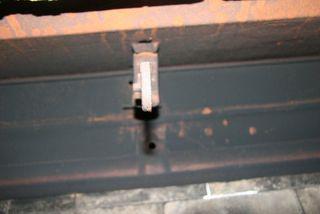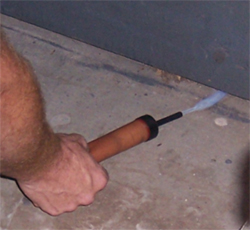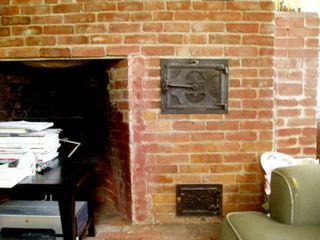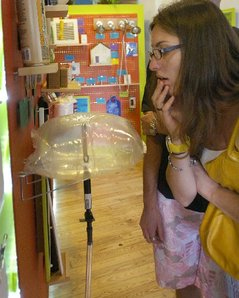
by blogediter | Mar 22, 2019 | Fireplaces
Q: Jason, I am very interested in a Chimney Balloon for my fireplace damper. I have a question that does not appear to be answered in your FAQ’s. How do you install a Chimney Balloon with a dampener handle sticking down into the firebox area? I cannot remove the handle and it would seem to be an object preventing a seal. I am sure there is an answer to this and await your reply. – DS
A: Hi DS, I don’t mean to be picky about vocabulary (It was not my strong suit in school either) but the correct word for the metal door in the fireplace is a “fireplace damper“. It is a common slip of the tongue, people call them dampers all the time.
In your particular application, I would recommend that you take your Chimney Balloon measurement above the damper opening. This location will get your Chimney Balloon up and out of the way of the damper hardware that is below the damper door.
From the picture, it looks like the damper is nice and low, but photos of flues can be deceiving in depth. If you cannot easily touch the damper door with two hands I would recommend you purchase a HEK valve extender with your Chimney Balloon to make the inflation go easier. – Jason

by blogediter | Mar 20, 2019 | Save Energy
We did quite a bit of research on Smoke Pencils and smoke sticks before we selected one to be offered through our website. We tested and tried at least one of each variety that is on the market. We ended up going with the Smoke Pencil, but here are the pros and cons of each of the types of Smoke Pencils, Smoke Sticks, and Smoke Puffers.
Acid Based Smoke Puffers:
There are a few brand varieties of the acid based smoke puffers. The most common are the Retrotec and TT Smoke Sticks. They operate on a mixture of acids that create the chemical smoke.
Pro:
– The smoke consistency is very good for draft detection.
– The squeezable smoke sticks were nice (as pictured) because it was easier to control the quantity of smoke.
Cons:
– Because they are acid based you have to pay extra for hazardous material shipping via UPS
and the US mail will not ship them at all. This also presents an issue if you have to travel by plane with them to a work location. TSA will not allow them on commercial aircraft.
– The smoke is corrosive and irritating to the eyes and nose if you are working in a closed in areas like a drop ceiling or crawlspace.
– If exposed to excessive heat (like if you left them in your work truck on a hot day) the smoke pencils can sometimes “blowout or meltdown” so they are best kept away from your other tools and in a sealed container like a welding rod case. Don’t store them by your new IR camera.:)
MSRP Cost: around $60
Glycol and Glycerin Based Smoke Puffers
: These smoke pencils are battery operated smoke sticks. A very small internal heating element heats the Glycerin, Glycol & Water solution to produce a fine steam that looks like smoke.
Note: This was the type of Smoke Pencil we chose to sell on www.chimneyballoon.us.
Pros:
– The smoke is non-toxic, smells faintly sugary and is of a good consistency for draft testing.
– The smoke quantity and on/off feature is easy to control by the trigger on the device. They have a built-in LED light that helps illuminate the area you are testing.
– Batteries last a long time in this device but rechargeable batteries are recommended.
Cons:
– Some condensation takes place in the nozzle so after long periods of use you will have to empty the overfill tank that collects this condensation.
– The smoke fluid tank only holds about 1/2 oz of fluid so it sometimes requires more fluid between jobs.
– They are an allowable device by TSA on commercial flights, but they look suspiciously like drug paraphernalia on an x-ray scanner so expect that your package/luggage will get checked. If you are traveling by air with it keep some batteries handy and an MSDS sheet, since TSA will want to see the thing work and see the MSDS on it
MSRP Cost: Around $25
Silica Based Smoke Puffer:
This smoke puffer sold by Regin operates by jetting out a very fine silica powder. There are a variety of different silica puffer types that are larger with bulb type squeeze actuators and smaller bottle types (in the picture). They are often used in chemical lab environments since Silica is a relatively non-reactive substance.
Pro:
– The “smoke” is non-toxic. This item can easily be shipped or taken on a plane for travel without hassle.
Cons:
– Although the Silica is non-toxic it tends to hang in the air and cause sneezing and coughing.
– The powder also can be hard to see in poorly lit areas.
– The Silica powder will collect as dust on flat surface areas and make a bit of a mess.
– You cannot squeeze the bottle while upsizing down or it will spit out a flaky silica blob.
– Overall it is difficult to control the smoke quantity so you can detect drafts.
MSRP Cost: Around $10
Incense Sticks “The Makeshift Smoke Stick”:
Inevitably Rookie energy raters or homeowners will ask, “Why don’t you just use an incense stick to test for air sealing and drafts?”
Any Home performance Professional can tell you from experience that you don’t want to be inspecting a home with a lit incense stick in your hand. You are constantly moving stuff around and crawling around looking for air leakage. If you use an incense stick, inevitably you will set it down in the wrong place or have ash or an ember fall off of the stick and burn or stain the carpet, furniture or floor. Paying for a bo-bo like that makes the relatively inexpensive Smoke Pencil look like a pretty good investment. As a matter of fact keep a spare smoke stick handy in the service truck.
Pros:
–They are cheap, and you can buy them at any dollar store.
– The smoke is adequately visible.
Cons:
– They smell pungent and the smell hangs in the air.
– You run a very good chance of burning yourself or the carpet, furniture, etc… since you cant turn them off.
– They drop hot ash and embers.
– You can’t set them down while you work.
– They produce too much smoke.
MSRP Cost: Six for $1

by blogediter | Mar 18, 2019 | Fireplaces
Q: Jason, One of the fireplaces in our 1844 house has an oven built into the fireplace hearth face, which we’ve never used. The oven has a door, and there is a clean-out door below the oven door. Can you make a guess if the Chimney Balloon would seal off the oven as well as the fireplace in one shot? Thanks, MB
A: Dear MB, A picture is worth a thousand words. Thank you for that photo of the hearth fireplace oven.
Sealing both with one Chimney Balloon is not recommended since you don’t know how high up the connection may be in the flue. I would sell them individually.
On the fireplace…I would measure the area where the fiberglass is at (I can see the yellow sticking down just below the lintel). I understand that is a trapezoid shape, so you will need a measurement of the front, the back, and the depth of that flue opening.
If this main fireplace flue has a fireplace damper you will also want a measurement above the damper since that may be a better location to install a Chimney Balloon if the damper hardware is in the way in the lintel area. Sealing the large flue is the main issue and that will stop most of the air infiltration, so let’s do that first.
If you still have the draft coming through the hearth oven then we can do a separate Chimney Balloon for that inlet. My suggestion for the oven would be to measure the shoot that runs out of the top or side of the oven enclosure. It should be a smallish rectangle or square vent heading up like a chimney.
With those measurements, we can get this fireplace air sealed, so the cold draft is not an issue anymore. – Jason

by blogediter | Mar 15, 2019 | Press
I was thumbing through the Department of Energy Blog and saw a great article written by Drew Bittner on Fireplaces.
I believe the article correctly called out the fireplace on its wasteful ways by saying it is an “a great big hole going to the outdoors”. Absolutely Drew! I couldn’t have said it better myself.
Just because a fireplace flue and damper is tucked out of sight doesn’t mean it does not let heat out or let cold drafts in. Also, when you go to use the fireplace you are just accelerating the rate it is exhausting your interior air. I consider it my personal crusade to let homeowners know that fireplace use does not always mean you are supplementing your homes furnace heat! In many cases, fireplace use simply wastes furnace heat and wastes the wood or gas you burn in the fireplace. – Jason

by blogediter | Mar 13, 2019 | Press
Where to Measure a Heatelator Pre-Fab Fireplace
Green Energy retail boutique stores are opening online and in brick and mortar all over the US and Canada. These stores offer homeowners tips and product that are used by professional energy raters and insulators to seal insulate your home and ensure it has proper efficient ventilation.
Here is a story about a “Clean Energy Boutique store” that was recently opened in Ypsilanti, MI near Ann Arbor, MI (story written by Tracy Davis, Ann Arbor News). This initiative is presented by the Clean Energy Coalition.
As always, education and exposure of homeowners is a key first step to getting homes more energy efficient.
In Photo: Camille Merritt checks out a chimney balloon, which seals the chimney from cold air when not in use, at the Energy Outlet, a green business launched by the Ypsilanti-based nonprofit organization Clean Energy Coalition.
Photo by Leisa Thompson, The Ann Arbor News.




